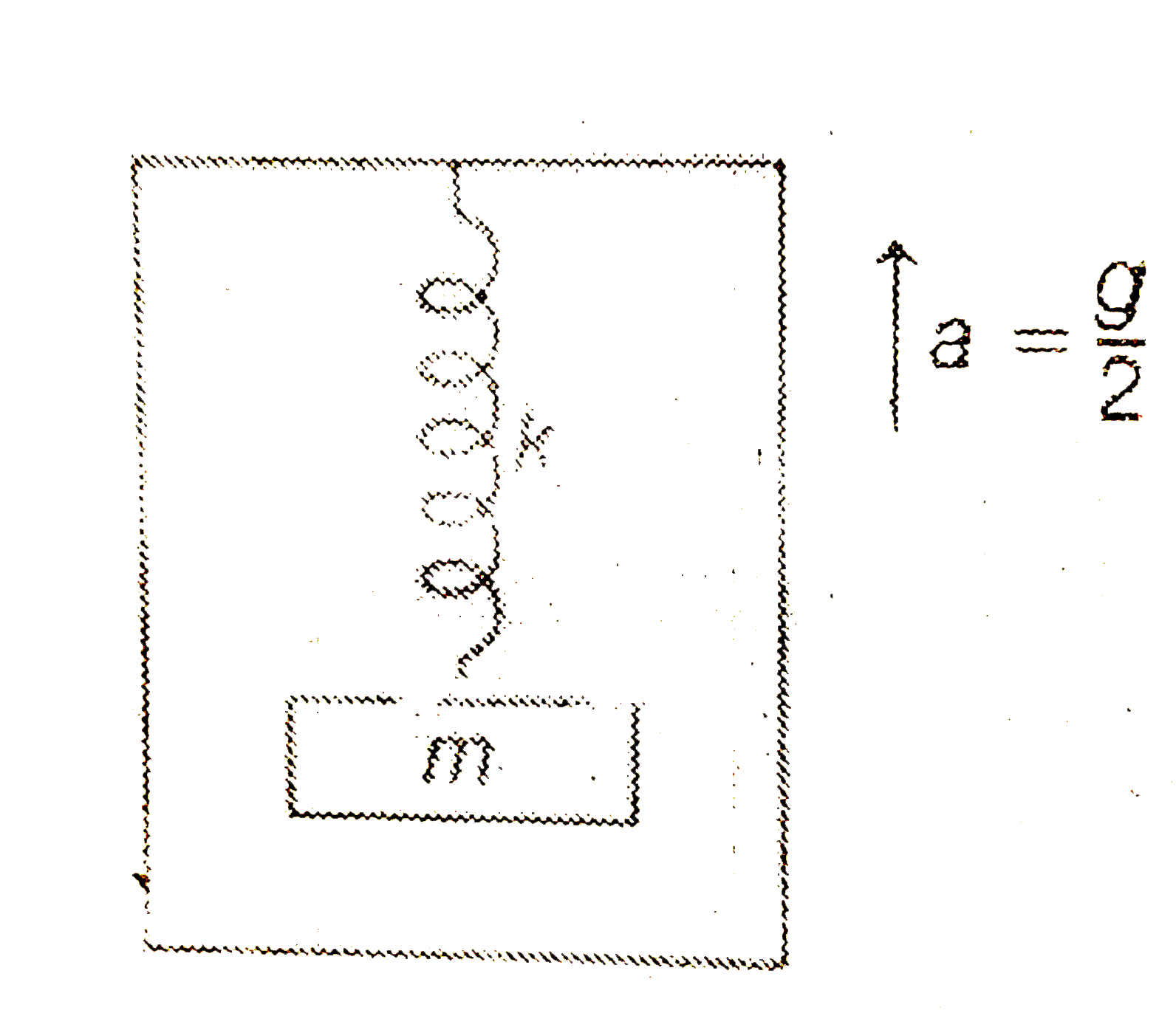A wooden block is floating on water kept in a beaker. 40% of the block is above the water surface. Now the beaker is kept inside a lift that starts going upward with acceleration equal to g/2. The block will then
sink
float with 10% above the water surface
float with 40% above the water surface
float with 70% above the water surface
The correct Answer is:B
To solve the problem, we need to analyze the situation step by step.
Step 1: Understand the initial condition
Initially, 40% of the wooden block is above the water surface, which means 60% of the block is submerged.
- Let the total height of the block be h.
- Height above the water surface = 0.4h
- Height submerged in water = 0.6h
Step 2: Analyze the effect of the lift's acceleration
The beaker is in a lift that accelerates upwards with an acceleration of g2. This changes the effective gravitational force acting on the block.
- The effective gravitational acceleration g′ when the lift accelerates upwards is given by:
g′=g+g2=3g2
Step 3: Apply Archimedes' principle
According to Archimedes' principle, the buoyant force acting on the block must equal the weight of the block for it to float.
- The weight of the block W is given by:
W=mg
- The buoyant force Fb is equal to the weight of the water displaced by the submerged part of the block. If V is the volume of the block, then:
Fb=density of water×g×volume submerged
Step 4: Calculate the new conditions
When the lift accelerates, the effective weight of the block changes due to the increased effective gravity.
- The new effective weight of the block is:
W′=mg′=m⋅3g2
Step 5: Set up the equilibrium condition
For the block to float, the buoyant force must equal the new effective weight:
Fb=W′
Substituting the expressions:
density of water⋅g⋅Vsubmerged=m⋅3g2
Step 6: Determine the volume submerged
Let Vsubmerged be the volume of the block that is submerged. Initially, 60% of the block was submerged, so:
Vsubmerged=0.6V
Substituting this into the buoyant force equation:
ρ⋅g⋅(0.6V)=m⋅3g2
Step 7: Relate mass and volume
Since m=ρV:
ρ⋅g⋅(0.6V)=ρV⋅3g2
Step 8: Simplify the equation
Canceling ρ and g from both sides:
0.6V=32V
This implies:
0.6=32⋅fraction of volume submerged
Solving for the fraction of volume submerged:
fraction of volume submerged=0.61.5=0.4
Step 9: Calculate the new height above water
If 60% of the block was submerged initially, and now it is only 40% submerged, then:
- Height above water = 100%−40%=60%
Thus, 10% of the block will be above the water surface.
Conclusion
The block will float with 10% of its height above the water surface.
Initially, 40% of the wooden block is above the water surface, which means 60% of the block is submerged.
- Height above the water surface = 0.4h
- Height submerged in water = 0.6h
The beaker is in a lift that accelerates upwards with an acceleration of g2. This changes the effective gravitational force acting on the block.
g′=g+g2=3g2
According to Archimedes' principle, the buoyant force acting on the block must equal the weight of the block for it to float.
W=mg
- The buoyant force Fb is equal to the weight of the water displaced by the submerged part of the block. If V is the volume of the block, then:
Fb=density of water×g×volume submerged
When the lift accelerates, the effective weight of the block changes due to the increased effective gravity.
W′=mg′=m⋅3g2
For the block to float, the buoyant force must equal the new effective weight:
Fb=W′
Substituting the expressions:
density of water⋅g⋅Vsubmerged=m⋅3g2
Let Vsubmerged be the volume of the block that is submerged. Initially, 60% of the block was submerged, so:
Vsubmerged=0.6V
Substituting this into the buoyant force equation:
ρ⋅g⋅(0.6V)=m⋅3g2
Since m=ρV:
ρ⋅g⋅(0.6V)=ρV⋅3g2
Canceling ρ and g from both sides:
0.6V=32V
This implies:
0.6=32⋅fraction of volume submerged
Solving for the fraction of volume submerged:
fraction of volume submerged=0.61.5=0.4
If 60% of the block was submerged initially, and now it is only 40% submerged, then:
- Height above water = 100%−40%=60%
Thus, 10% of the block will be above the water surface.
The block will float with 10% of its height above the water surface.
Topper's Solved these Questions
Similar Questions
A wooden block is floating in a water tank. The block is pressed to its bottom. During this process, work done is equal to :
View SolutionA block of wood floats on water with 25 th of its volume above the water surface. Calculate the density of wood.
View SolutionA wooden block is floating in a liquid. About 50% of its volume is inside the liquid when the vessel is stationary, Percentage volume immersed when the vessel moves upwards with acceleration a=g2 is
View SolutionA wooden block is floating in a liquid. About 50% of its volume is inside the liquid when the vessel is stationary, Percentage volume immersed when the vessel moves upwards with acceleration a=g.2 is
View SolutionA cubical block of density ρ is floating on the surface of water. Out of its height L, fraction x is submerged in water. The vessel is in an elevator accelerating upward with acceleration a. What is the fraction immersed ?
View SolutionA block of wood is floating on the surface of water in a beaker. The beaker is covered with a bell jar and the air is evacuated. What will happen to the block ?
View SolutionA spring balance and a physical balance are kept in a lift. In these balance equal masses are placed. If now the lift starts moving upward with constant acceleration, then.
View SolutionA spring balance and a physical balance are kept in a lift. In these balance equal masses are placed. If now the lift starts moving upward with constant acceleration, then.
View SolutionA wooden object floats in water kept in as beaker. The object is near a side of the beaker figure. Let P1,P2,P3 be the pressure at the three points A,B and C of the bottom as shown in the figure.
 View Solution
View SolutionPassage VII There is a spring block system in a lift moving upwards with acceleration a=g2

In mean position (of block's oscillations) spring isView Solution

